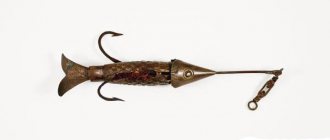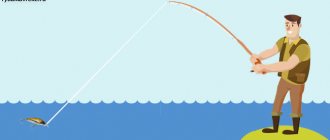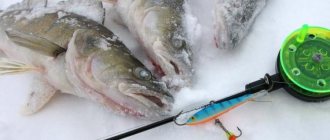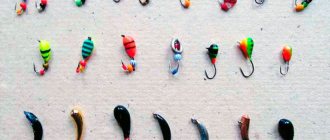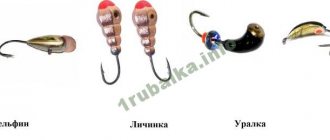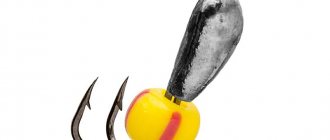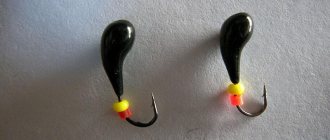This is a jig an invention of Russian fishermen, and its appearance was in some way accidental. This event dates back to the mid-20th century, when Siberian fishermen tested a tackle with a lead weight and a pellet located right next to the hook. What is a jig, where is it used and what types exist, we will consider in this article.
This arrangement of the load changed the mechanics of the equipment and increased its attractiveness for both white and predatory fish, pike perch and perch. Since then, the jig has been actively used in ice fishing, and it shows excellent results.
The name arose by analogy with mormysh, a small crustacean that is found in most reservoirs and is held in high esteem by fish. For fishing with bait, winter fishing rods with a nod are used.
Winter fishing is fundamentally different from summer fishing, this applies not only to the gear used, but also to the baits and baits used. In cold water, the inhabitants of reservoirs are not active in search of food, and in order to still attract their attention, original equipment is used.
Varieties of jigs
Jigs are divided into many groups and types according to different characteristics; it is simply impossible to tell about each one. The bait is constantly being improved, new types appear, and details are added to existing ones. For a novice angler, it’s quite easy to get lost in the variety, so let’s try to divide jigs into several main types.
Winter
The most common are winter jigs; with their help you can catch even inactive fish. They are distinguished by their small size, but their shape and color can be very different. To attract the attention of the inhabitants of the reservoir, they often additionally put artificial or live bait on them.
Winter jigs can be roughly divided into:
- perch is usually caught using a product from 2 mm to 6 mm in size, most often a bloodworm is placed on the hook;
- a large version of an oblong shape is perfect for catching pike perch; this predator is attracted by its white color;
- The clamp jig has a small hook and is designed for a small catch; baiting bloodworms will be problematic, so there is a kind of clothespin located near the hook;
- baitless species are distinguished by a large number of cambrics and beads used, which attract fish.
The weight of all these species varies greatly, it all depends on the reservoir, its depths, inhabitants, water transparency, and bottom topography.
Summer jigs
It is quite easy to distinguish the winter type from the summer one, although in most cases the shape will be identical. So, the summer version has the following characteristics:
- the size of summer jigs is much larger than winter jigs;
- color preference remains with copper or brown, other colors will be less popular;
- A ball or drop is most suitable for fishing in the summer.
Victoria Leshchenko
I've been working hard in the fishing tackle department for the past six years. I can help you assemble almost any gear.
Ask a Question
For individual bodies of water, other shapes and colors are sometimes used; the selection of jigs often requires an individual approach.
For fishing with bait
For fishing from ice with bait in the form of bloodworms or worms, jigs of various shapes are used, and in addition there will be no multi-colored cambrics or beads on the hook.
Often jigs have a fairly large hook, this allows you to attach a bunch of bloodworms or use a small worm without cutting it.
The color is selected individually, but the best fishing is for black-colored products.
Nozzleless
Fishing without the use of baits of animal origin makes its own adjustments to the appearance of the product. To attract the attention of residents of the reservoir, who are not particularly active in winter, jigs are equipped with multi-colored accessories of artificial origin. Most often used:
- beads;
- sequins;
- cambrics.
Some have brass balls or cubes; this innovation has recently come to us.
Nozzle jigs can have one, two or three hooks, depending on this their name changes:
- a nozzle jig with a double hook is called a goat;
- a triple fixed hook is characteristic of the devil;
- The so-called witch has three hooks located on opposite sides of the body of the jig and moving freely.
Single-hook baits have many names, in most cases it comes from the shape of the body of the jig or from additional accessories.
These are the main types, but there are many more different products.
Winter fishing
A trip to a lake or river begins with choosing a place. First, a test catch is made, for which several holes are drilled. For winter fishing you need to have a whole set of jigs and baits, since you don’t know what exactly the catch will bring. Perch is a schooling fish, so attacking a predator in this case is considered a great success. It is advisable to throw bait into the hole with the best bites to secure the bite.
Thick ice not only provides safety, but also acts as a good barrier between fish and humans. It is doubly better if the ice surface is covered with a layer of snow. Under such ice, the perch does not feel danger and is ready to actively hunt. It has been noticed that the bite increases in sunny weather with slight frost. At the same time, the sun helps the fish notice the hole, so the water in the hole must be shaded by throwing a handful of snow there. The wind is a bad ally for a fisherman. It is advisable to fish in calm weather or during a lull, and it is better to sit at the hole with your back to the wind.
Winter jigs for perch are most often equipped with bloodworms. This is a universally working bait. Thread the bloodworm onto the hook entirely from the tail. But you can put on a ring with a bunch of larvae, which is more attractive to fish. Maggot has also proven itself well, as well as a combination of these two types of bait, which is called a “sandwich”. And earthworms and dung worms are considered ideal bait for both perch and roach. The only problem is that it is difficult to get it in winter.
The most economical and convenient is the so-called reelless jig. In this case, traditional bait is not put on at all. Instead, skillful fakes are made that can arouse the appetite of a predator and provoke a bite. The same popular drop, otherwise known as banana, attracts fish very well. The fisherman does not need to prepare bait, change it during fishing, or adapt it for perch, roach or other fish. The jig rod must have sufficient elasticity and flexibility so that it can provide the necessary vibrations and withstand large fish.
Gear selection
On store shelves there is a very large selection of jigs of different colors and shapes, and accordingly they will vary in weight. It often happens that a very small product has significant weight, and a large jig turns out to be lighter. What is the reason? Why does this happen?
This difference in size is explained by the material from which the tackle was made. The most common are lead and tungsten products, less common are silver and Wood's alloy.
Cargo material
The production of jigs occurs both at home and in factories. For this use:
- lead, their products are larger in size, but their specific gravity is much less. Ease of processing allows this material to be used for making products at home.
- Tungsten products, even with a small size, are quite heavy; processing such material at home is problematic. With this type of load, jigs are used in currents and great depths.
Victoria Leshchenko
I've been working hard in the fishing tackle department for the past six years. I can help you assemble almost any gear.
Ask a Question
Most often, experienced fishermen choose tungsten, but lead is also popular.
Form
Beginner fishermen, going to the store to buy tackle, believe that they can buy a couple of universal jigs, the shape of which will be attractive to all types of fish. But this is not at all true; the concept of a universal form simply does not exist.
When choosing a jig according to its shape, you should consider the following requirements:
- voluminous products will attract the attention of the inhabitants of the reservoir better;
- variants flattened at the top and bottom will raise a cloud of turbidity;
- a droplet and a ball create fountains of turbidity;
- a flat-shaped product plays especially well, creating a cloud of turbidity and simultaneously dispersing it, which especially attracts perch;
- uralka and ant work great with nodding movements;
- a jig with a cone-shaped body sinks slightly into the silt when lowered to the bottom;
- a ball, an oatmeal, a droplet will become saviors in the dead of winter;
- The devil is especially effective for catching perch, roach, bream and chub.
Many people believe that the ball and the droplet have a universal shape, but one can argue with this. Jigs in the form of a larva, ant, or fly are no less effective for various types of fish.
Weight
Regarding weight, everything is simple; heavier jigs are used at significant depths, medium and strong currents. General recommendations depend on the fishing location:
- products up to 0.25 g will be effective at depths of up to 2 meters, small fish will react;
- starting from 0.25 g and more, the product will attract the attention of a predator at depths of up to 4 m.
Large jigs are used by fishermen with experience in the first ice and before opening reservoirs, but the small size of the jigs will allow the game to be played more delicately.
Color
Color is also important; it is selected depending on weather conditions and the characteristics of the reservoir. To be sure of your catch, you should start from the following indicators:
- in sunny weather, darker colors of the product are used; on bright days, you can use a black jig all season long;
- depths of up to 6 m. It is worth fishing with copper products, it is to them that the inhabitant of the reservoir will respond best;
- silver and gold will work in cloudy weather, and the dark soil at the bottom of the reservoir will perfectly shade such a bait.
In reservoirs with depths of 10 meters, there is no need to change baits; absolutely any color will work.
Victoria Leshchenko
I've been working hard in the fishing tackle department for the past six years. I can help you assemble almost any gear.
Ask a Question
The more snow on the ice, the lighter the jig is tied; fishing on the first ice is always successful with dark colors, in particular black ones.
Hooks
The hook on the jig must correspond to the body; too large can scare away the fish, and a small one will not allow you to detect when biting. It is best to choose wire types; hardened ones will break when caught, which means you will have to re-tie the tackle. Steel wires will simply bend.
It is worth understanding that a real fisherman should have a variety of products in his arsenal. You can’t get hung up on one shape or color. To be successful, you need to constantly experiment.
Winter jigs
This type of bait occupies a separate place in their qualifications, since the very idea of combining a sinker and a hook was originally intended to activate the bite of passive fish during winter fishing.
Winter jigs are classified according to their weight into the following categories:
- Heavy ones are effective when fishing at significant depths and fast currents, since they tend to sink quite quickly.
- Medium weight - the most popular because they are considered universal, suitable for various fishing conditions.
- Lightweight - used in shallow waters and in the absence of current.
The best jigs for winter fishing are considered to be baits based on tungsten blanks, which have the following properties:
- high immersion speed and stable position even in the current due to the fairly large weight;
- a characteristic game that attracts fish, resulting in increased biting;
- quite small in size, since the material from which they are made has a high density;
- reliability and high strength.
The main types of winter jigs used by ice fishing enthusiasts are lures with bait, which is usually a bloodworm, and a baitless jig - a mothless jig. Using the latter, the fisherman needs to show all the skills and dexterity to make the bait look more appetizing and move more attractive to the fish.
Winter jigs occupy a separate place in their qualifications
Jig fishing technique
Fishing with a jig is best done using a nod; this addition to the tackle will allow you to play the bait better.
The process is not complicated, but it must be carried out competently. It is best to observe more experienced comrades, but if this is not possible, then everything should be done in the following sequence:
- Drill several holes, alternately feed with bloodworms or winter bait.
- Starting from the hole into which the bait was placed first, fishing is carried out.
- The jig is lowered to the bottom, a nod will help with this.
- Next, tapping on the bottom is carried out for 5-10 seconds.
- Until the cloud of turbidity dissipates, the jig must be raised, and this must be done quickly enough.
- When lifting, you can additionally swing the rod slightly, this will attract the attention of more fish.
- Then they pause for 4-8 seconds and begin to lower the jig.
Such movements are considered the basis, then each fisherman makes his own additions and innovations, choosing the most convenient and successful method of play for himself.
Jigs for fishing with attachments
Often, jigs are supplemented with natural baits - a worm, maggot, bloodworm, which helps, even in the case of imperfect mastery of the tackle itself and the tactics of its use, to attract fish and get a good catch.
The latest innovations in the field of bait are the use of artificial bloodworms and maggots, which in appearance are exactly similar to natural baits. Before use, such baits are placed in a special solution that helps acquire the smell of natural bait. So you get something in between natural and artificial bait.
Absolutely “naked” baits are used extremely rarely, since beads, pieces of rubber or foam rubber, cambrics, pieces of bright threads are placed on the hooks - anything that can additionally attract fish and provoke a bite.
The use of artificial bloodworms and maggots is the latest innovation in the field of bait
How to bind
The outcome of a fishing trip often depends on how securely the jig is tied. It happened to many, even experienced fishermen, that the fish left along with the jig. Often the cause is incorrectly tied tackle.
To protect yourself from such troubles, you should learn how to knit a jig correctly. Tying methods mainly differ due to the type of jig; it is believed that products with a hole are more difficult to tie than a jig with an eye. You can securely bind in this way:
- first of all, they pass the fishing line through the hole in such a way that the length is enough for the knot;
- form a loop along the shank of the hook and press it with your finger;
- with the other hand make several turns of fishing line around the fore-end;
- the free end is pulled into the loop;
- holding the winding on the forend, get to the main one and tighten the knot.
To prevent the fishing line from slipping during fishing, it is advisable to burn the tip of the fishing line with a hot needle or a hot match.
Self-production
Previously, purchasing a jig of the required shape and weight was problematic. Craftsmen made them themselves in several ways. Many have still not given up on this, the home production of jigs has recently experienced a second revival, many fishermen remembered their former occupation and sat down to make catchy types of bait.
Most often, people make their own products from lead; to do this, it is melted and then sent into molds. Jigs are produced at home in several ways:
- cast;
- cut out;
- soldering.
Each of the names of the process speaks for itself, and without special skill you should not get down to business.
Lead baits without casting
The longest manufacturing method is casting jigs. But using this method, with your own hands, you can repeat the shape of the most catchy jigs and make their exact copies. You don’t have to be afraid of losing the best bait, because you’ll have the same ones in stock. Jigs are cast from lead.
Casting mold
How to make a jig, and even with your own hands? To do this, you need to make a casting mold. For small specimens, an epoxy resin mold is used. For larger ones, a mold is made from plaster. Moreover, it is better to take gypsum not for construction, but to buy material for children’s crafts.
To cast a plaster mold, you can use a matchbox as a base. The gypsum mixture is poured into the box. The mixture is properly prepared from 1 part sugar-sweetened water (for strength) and two parts gypsum. All components should be well mixed to the consistency of sour cream. The box is filled to the brim, the surface is leveled, and the excess is removed.
The jig that you want to repeat is dipped in a thick soap solution, the consistency of jelly, then you need to let it dry. After this, drown the jig halfway into the plaster. In order to be able to pull it out later, two pieces of plastic juice tube are inserted vertically into the plaster, in opposite corners of the matchbox, to the very bottom. The length of these segments is 2 centimeters.
After 15 minutes, after the plaster has hardened, the entire surface is once again coated with a soap solution. Another part of the gypsum mixture is poured into another matchbox. It also levels out.
The next way to make a jig is simpler. It also uses lead, which is very plastic in its structure and allows you to make a jig without casting. In this way you can make a “Nymph” or “Goat” jig.
Homemade Nymph
On an anvil, you need to beat off a piece of lead with a hammer. You will make blanks from it as follows:
- Take the hook with a flame, heat the eye and use pliers to bend it inward. Clean the hook well with a file. Take the hook with pliers, apply it to the lead and cut off a piece of lead of a suitable size.
- A piece of lead must be thoroughly cleaned and a recess made for the hook.
- The hook and the recess under it are tinned with melting acid.
- Tin is used to properly solder the hook to the lead blank.
- Again, everything is cleaned with a file and fine-grained sandpaper.
- Can be painted.
Homemade Devil
The method by which you can make a “Devil” jig from lead with your own hands is simple and uncomplicated.
Storing jigs
It is recommended to store jigs in special boxes with a special liner made of cork or polyurethane. It is better not to use foam rubber for these purposes; the hygroscopicity of the material can play a cruel joke.
It is also worth paying attention to the fact that after each fishing it is necessary to thoroughly clean the jig hook from bloodworms, mud, fish remains and dry it. If this is not done very quickly, even high-quality jigs will rust and become unusable.
What types of jigs are there?
Even the most uninitiated amateur fisherman knows what a jig is.
Even for those who go out several times a year with gear covered in dust in a closet or garage, carry out a ritual of, if not fishing, then “bathing a worm.” But as soon as the question arises about the types of jigs and their specific purpose, things are already worse. After all, not everyone knows that there are jigs in the form of insects and parrot jigs, and it will be even more difficult to classify their types. We hope that after reading this article, no one will have any unresolved questions regarding jig models, and anyone will be able to participate in a conversation about the types of jigs for perch along with professionals.
Top 5 best jigs
Among a large number of different jigs, we still managed to choose the five most catchy models that are caught always and everywhere.
The most popular among both experienced anglers and novice fishermen are these several models.
Ant 3.0/2 86601-0.2
The lead version of the jig is made here, but the hooks are of high quality, Japanese. The weight may vary, but the most popular product is considered to be 0.28 g. Additionally, the jig is equipped with yellow cambric or red beads.
"Lucky John 20 S"
This model refers to jigs with three hooks, namely devils. The body has three sides, is made of lead, but is quite expensive, on par with tungsten products. Produced in Latvia, the jig has a loop and is equipped with beads and cambrics. Perfect for fishing in the middle of nowhere, it will not leave pike, pike perch and large perch indifferent. Product weight from 0.25 g.
"Lucky John LJ 13050-139"
This type of jig is classified as a heavy one, used to catch predators in the current. The shape of the product resembles the Uralka, the body is equally elongated. With a diameter of about 5 mm and a weight of 1.3 g, the jig is made of tungsten and additionally coated with high-quality polymers. Equipped with sequins and beads, which allows you to catch fish without using live bait.
"Lumicon Female Ant d.3.0"
The jig is very reminiscent of the corresponding insect, the game of which will be almost completely identical to the floundering of an ant in water. All predators in the reservoir are targeting the product.
Nozzle jigs
Any model of this type of jig is characterized by a basic property - their use does not involve the use of natural bait, and their attractiveness is ensured only by the unique nature of the bait’s play in the water.
Among the reelless jigs, the most popular types are:
- Uralka is popular among those who like to hunt perch. Fishing tackle stores usually offer a large selection of this type of reelless hook, differing from each other in size, color, and the presence of beads of different shades at the base of the hook;
- devil is the most catchy bait for pike perch, equipped with three or even four hooks;
- goat is a type of devil, although many distinguish it as a separate independent species. This jig is made primarily from copper or brass. The number of hooks a goat has is less than that of a devil, and in order to ensure effective fishing with it, you need to know the intricacies of placing the bait;
- boat - designed for catching peaceful fish, therefore it requires active wiring. Its colors are quite diverse, and the design is improved with additional elements that attract the inhabitants of the aquatic depths;
- ant - a bait with a body divided into segments. Its very name indicates the similarity of the jig to a living insect, and the nature of the movements with a small amplitude exactly imitate the behavior of an ant that has fallen into the water. All baits of this type have approximately the same weight - 0.3 g, although it can be increased by adding beads to make it heavier;
- donkey - a bait similar to a quarter of a coffee bean, mostly black. It is considered almost universal, since it has shown itself well in and without current.
But no matter which of the listed types of baitless jigs the fisherman chooses, he will be able to determine the catchability of the bait only by testing in practice, under certain conditions, fishing on a specific body of water.
Nozzle jigs

